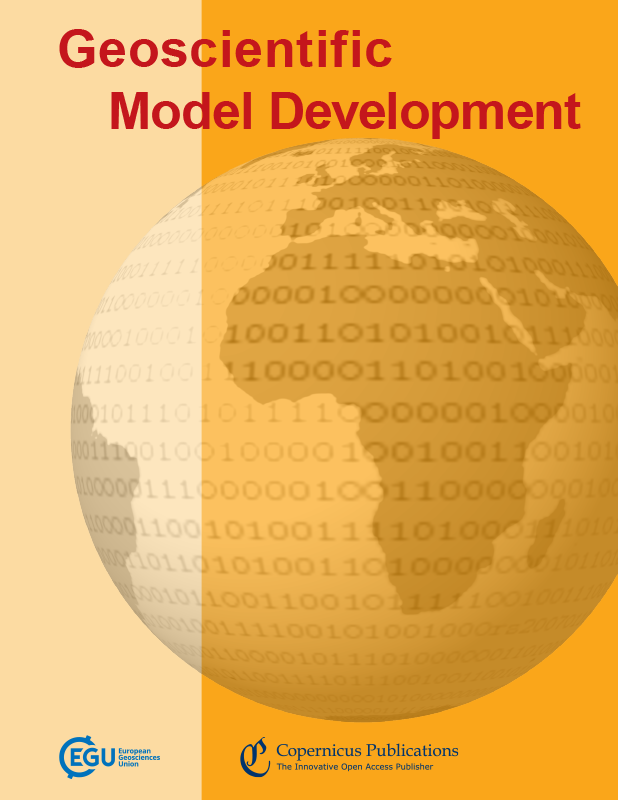Development of inter-grid-cell lateral unsaturated and saturated flow model in the E3SM Land Model (v2.0)
IF 4.9
3区 地球科学
Q1 GEOSCIENCES, MULTIDISCIPLINARY
引用次数: 0
Abstract
Abstract. The lateral transport of water in the subsurface is important in modulating terrestrial water energy distribution. Although a few land surface models have recently included lateral saturated flow within and across grid cells, it is not a default configuration in the Climate Model Intercomparison Project version 6 experiments. In this work, we developed the lateral subsurface flow model within both unsaturated and saturated zones in the Energy Exascale Earth System Model (E3SM) Land Model version 2 (ELMv2.0). The new model, called ELMlat, was benchmarked against PFLOTRAN, a 3D subsurface flow and transport model, for three idealized hillslopes that included a convergent hillslope, divergent hillslope, and tilted V-shaped hillslope with variably saturated initial conditions. ELMlat showed comparable performance against PFLOTRAN in terms of capturing the dynamics of soil moisture and groundwater table for the three benchmark hillslope problems. Specifically, the mean absolute errors (MAEs) of the soil moisture in the top 10 layers between ELMlat and PFLOTRAN were within 1 %±3 %, and the MAEs of water table depth were within ±0.2 m. Next, ELMlat was applied to the Little Washita experimental watershed to assess its prediction of groundwater table, soil moisture, and soil temperature. The spatial pattern of simulated groundwater table depth agreed well with the global groundwater table benchmark dataset generated from a global model calibrated with long-term observations. The effects of lateral groundwater flow on the energy flux partitioning were more prominent in lowland areas with shallower groundwater tables, where the difference in simulated annual surface soil temperature could reach 0.3–0.4 ∘C between ELMv2.0 and ELMlat. Incorporating lateral subsurface flow in ELM improves the representation of the subsurface hydrology, which will provide a good basis for future large-scale applications.在 E3SM 陆地模型(v2.0)中开发网格间横向非饱和与饱和水流模型
摘要地下水的横向输送对调节陆地水能分布非常重要。虽然最近有一些陆表模式包含了网格单元内和网格单元间的横向饱和流,但它并不是气候模式相互比较项目第 6 版实验的默认配置。在这项工作中,我们在能源超大规模地球系统模式(E3SM)陆地模式第 2 版(ELMv2.0)中开发了非饱和区和饱和区内的横向地下流动模型。新模型名为 ELMlat,以三维地下流动和传输模型 PFLOTRAN 为基准,对三个理想化山坡进行了测试,其中包括具有不同饱和初始条件的收敛山坡、发散山坡和倾斜 V 型山坡。在捕捉三个基准山坡问题的土壤水分和地下水位动态方面,ELMlat 的性能与 PFLOTRAN 相当。具体而言,ELMlat 和 PFLOTRAN 对顶层 10 层土壤水分的平均绝对误差(MAEs)在 1 %±3 % 之间,对地下水位深度的平均绝对误差(MAEs)在 ±0.2 m 之间。接下来,将 ELMlat 应用于 Little Washita 实验流域,以评估其对地下水位、土壤水分和土壤温度的预测。模拟地下水位深度的空间模式与根据长期观测数据校准的全球模型生成的全球地下水位基准数据集非常吻合。在地下水位较浅的低洼地区,横向地下水流对能量通量分配的影响更为突出,ELMv2.0 和 ELMlat 模拟的年地表土壤温度相差可达 0.3-0.4 ∘C。在 ELM 中纳入地下横向流改进了地下水文的表示,这将为未来的大规模应用奠定良好的基础。
本文章由计算机程序翻译,如有差异,请以英文原文为准。
求助全文
约1分钟内获得全文
求助全文
来源期刊

Geoscientific Model Development
GEOSCIENCES, MULTIDISCIPLINARY-
CiteScore
8.60
自引率
9.80%
发文量
352
审稿时长
6-12 weeks
期刊介绍:
Geoscientific Model Development (GMD) is an international scientific journal dedicated to the publication and public discussion of the description, development, and evaluation of numerical models of the Earth system and its components. The following manuscript types can be considered for peer-reviewed publication:
* geoscientific model descriptions, from statistical models to box models to GCMs;
* development and technical papers, describing developments such as new parameterizations or technical aspects of running models such as the reproducibility of results;
* new methods for assessment of models, including work on developing new metrics for assessing model performance and novel ways of comparing model results with observational data;
* papers describing new standard experiments for assessing model performance or novel ways of comparing model results with observational data;
* model experiment descriptions, including experimental details and project protocols;
* full evaluations of previously published models.
 求助内容:
求助内容: 应助结果提醒方式:
应助结果提醒方式:


